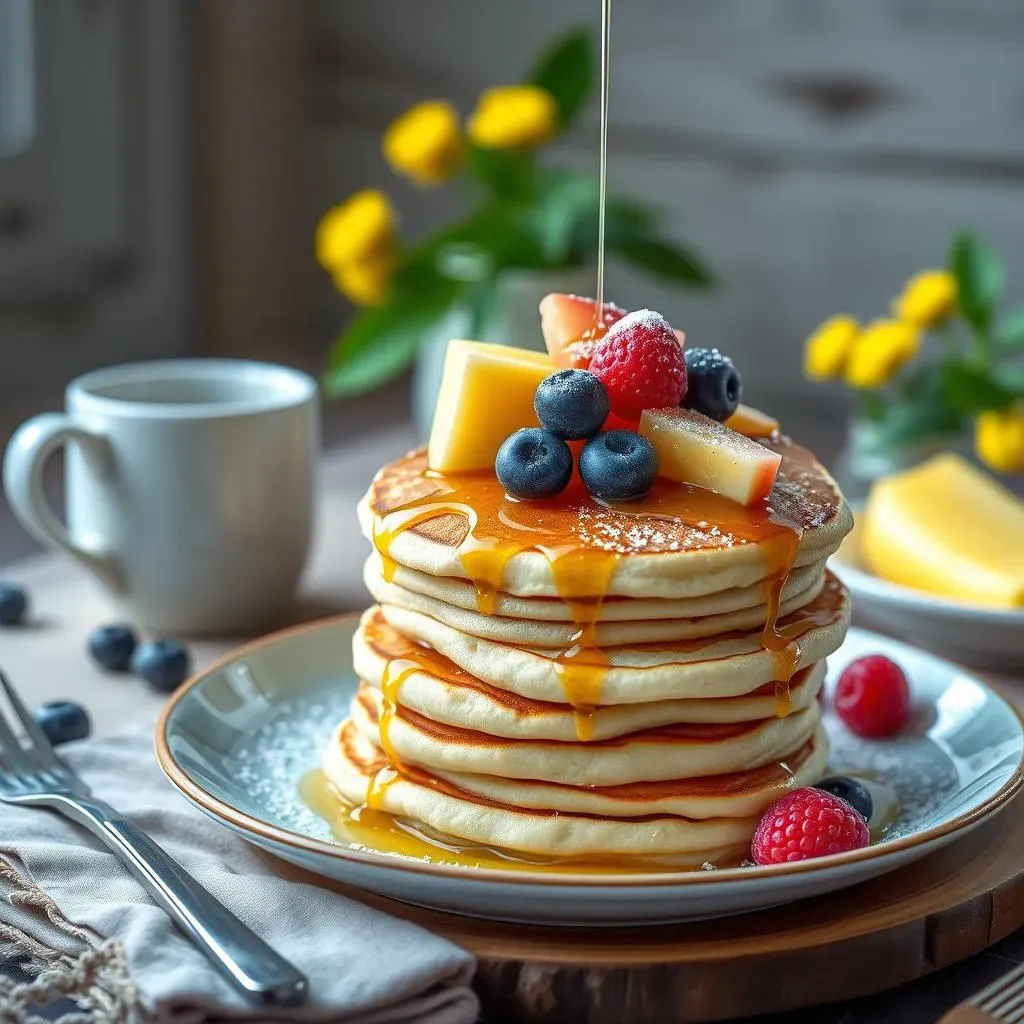Table of Contents
Weekend mornings should be about relaxation, not kitchen stress. That's where a good gluten-free pancake recipe comes in, especially if you're planning a leisurely brunch. I get it; gluten-free baking can feel like navigating a minefield, but trust me, making fantastic gluten-free pancakes is totally achievable. We’re going to walk through a recipe that's so simple, even a sleep-deprived parent could nail it. We'll start with gathering the right ingredients and equipment, then move to the mixing process, which is quicker than you think. Next, I'll share my tips for cooking these beauties to a perfect golden brown, followed by some fun ideas for toppings because let's be honest, that's where the party's at! I'll also cover how to keep those pancakes warm if you’re dealing with a slow-moving crowd, and yes, even how to freeze them for future pancake emergencies. We'll even peek at the nutritional information, just because. Finally, I'll share some reader feedback that shows how you can personalize this recipe to fit your taste. So, ready to conquer the world of gluten-free brunch with the best gluten-free pancake recipe for a weekend brunch? Let's get started!
Gather Your GlutenFree Goodies
Gather Your GlutenFree Goodies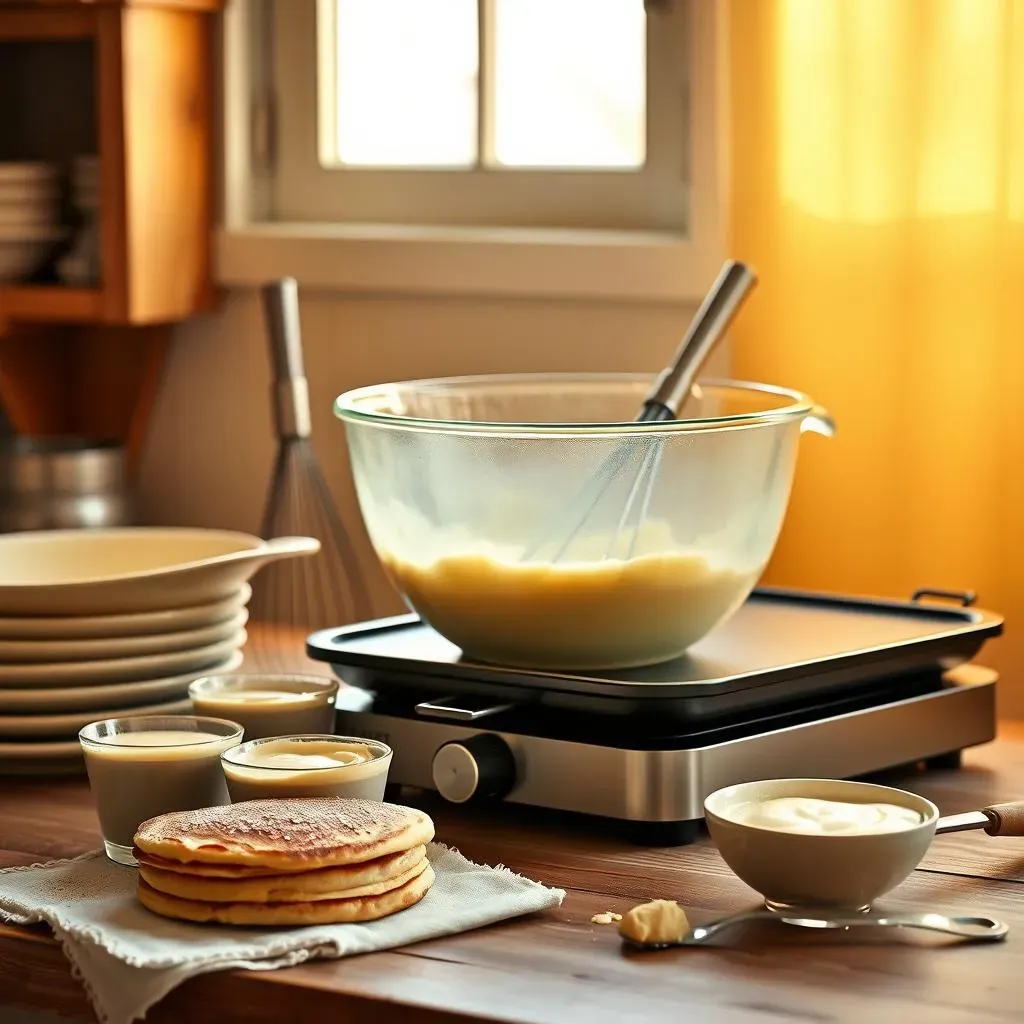
The Foundation of Flavor
Okay, let's talk ingredients. For a truly great gluten-free pancake, you can't just grab any old flour. You need a gluten-free flour blend, the kind that says "measure for measure" on the bag. This blend is vital because it usually includes a binder like xanthan gum, which is crucial for holding our pancakes together. If you are new to this, check out this easy gluten-free pancake recipe for beginners. Think of the flour blend as the base of a good house, it needs to be solid or everything falls apart, literally.
You will also need the usual suspects: milk (dairy or plant-based, your call), eggs (or a substitute if you're going egg-free, more on that later), a bit of sugar for sweetness, a touch of baking powder for lift, and a pinch of salt to balance it all out. Don't forget a little melted butter or oil for the griddle, and maybe some vanilla extract to add a bit of extra flavor. It's all pretty standard stuff, but each one plays a key part in creating that perfect pancake.
- Gluten-Free Flour Blend: Look for a "measure for measure" blend.
- Milk: Dairy or plant-based works.
- Eggs: Or a substitute if needed.
- Sugar: For sweetness.
- Baking Powder: For fluffiness.
- Salt: For balance.
- Melted Butter/Oil: For the griddle.
- Vanilla Extract: Optional, for extra flavor.
Equipment Check
Now, for the tools. You don't need a fancy kitchen gadget to make pancakes, but having the right equipment can make the job much easier. A large mixing bowl is a must, along with a whisk or a fork for mixing. I prefer a whisk, it gets the job done faster and more efficiently. A measuring cup and spoons are also essential for accurate baking. Remember, baking is a science, so precision is key.
For cooking, an electric griddle is my go-to, because it heats evenly. But, a large skillet, especially a cast iron one works great too. A spatula is essential for flipping your pancakes, and a ladle or a 1/4 cup measuring cup helps pour the batter evenly. It is important to have everything ready before you start, it will make the whole process much smoother.
Need a quick breakfast? Check out our gluten-free recipe for a quick breakfast.
Equipment | Why it's Useful |
|---|---|
Large Mixing Bowl | For mixing all the ingredients |
Whisk or Fork | To combine ingredients smoothly |
Measuring Cups and Spoons | For accurate measurements |
Electric Griddle or Skillet | For even cooking |
Spatula | For flipping pancakes |
Ladle or 1/4 Cup | For portioning batter |
Mixing Up the Magic
Mixing Up the Magic
Alright, so you've got all your ingredients and gear, now the fun part begins! First, grab that big mixing bowl and toss in your dry stuff: the gluten-free flour blend, sugar, baking powder, and salt. Give it a little whisk to make sure everything's evenly mixed, I find that this step is crucial for avoiding clumps later on. Now, for the wet ingredients; in a separate bowl, whisk together the milk, eggs (or your substitute), melted butter or oil, and vanilla extract (if you are using it). This step is important to make sure everything is combined before adding to the dry ingredients.
Next, pour the wet ingredients into the dry, and grab your whisk or fork. Gently mix until just combined, you'll want to see some lumps, and that is fine. Overmixing is the enemy of fluffy pancakes. Let the batter rest for about 5-10 minutes; this lets the gluten-free flour absorb the liquid and allows the baking powder to do its job. This resting time is a game changer. If you are looking for a comparison, this post about gluten-free pancake recipe comparison can help you understand more about different flour blends. I promise, your patience will pay off with fluffier pancakes.
Mixing Step | Why it Matters |
|---|---|
Whisk Dry Ingredients | Ensures even distribution |
Whisk Wet Ingredients | Combines liquids thoroughly |
Combine Wet and Dry | Mix gently until just combined |
Let Batter Rest | Allows flour to hydrate and baking powder to activate |
Cooking to Golden Perfection
Cooking to Golden Perfection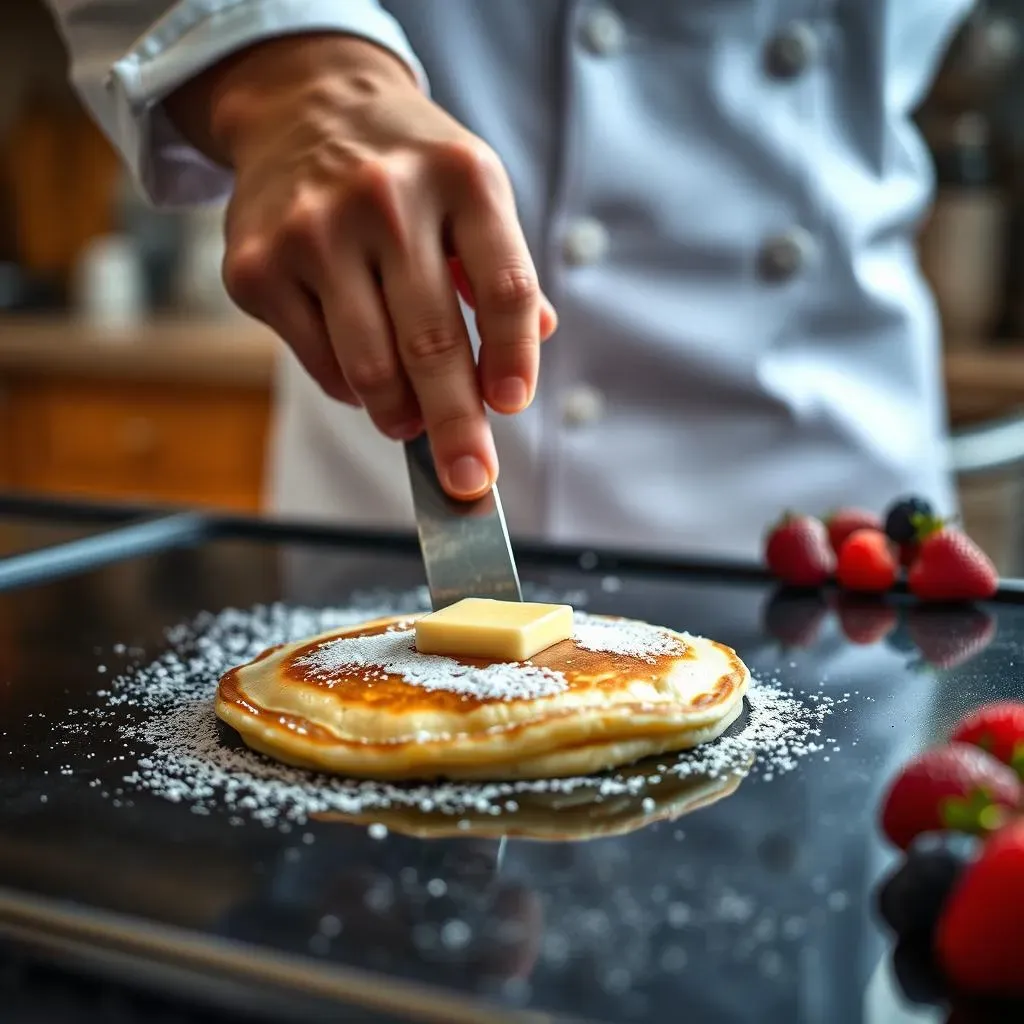
The Heat Is On
Okay, the batter's rested, and you're ready to make some magic happen. Preheat your electric griddle to about 350°F (175°C) or your skillet over medium heat. You'll know it's ready when a drop of water sizzles and evaporates quickly. Lightly grease the surface with a bit of melted butter or oil. This step is crucial for preventing those pancakes from sticking and turning into a sad, torn mess. Nobody wants that!
Now, pour about 1/4 cup of batter onto the hot surface for each pancake. Don't overcrowd the griddle or skillet, give them some room to expand. Let them cook for about 2-3 minutes per side, or until bubbles start to form on the surface and the edges look set. This is where patience comes in, resist the urge to flip them too early, or they might stick and break. If you are looking for a recipe with different flour, you can check our fluffy gluten-free pancake recipe using almond flour.
Cooking Tip | Why it Matters |
|---|---|
Preheat Properly | Ensures even cooking |
Grease Lightly | Prevents sticking |
Don't Overcrowd | Allows space for spreading |
Cook Until Bubbles Form | Indicates it's time to flip |
The Flip and Finish
Once you see those bubbles and the edges look cooked, it's flipping time! Gently slide your spatula under each pancake and flip it over. Cook for another 2-3 minutes on the other side, until they are golden brown and cooked through. If you are using a skillet, you may need to adjust the heat to avoid burning your pancakes. You'll want them to be nice and golden, not dark brown and crispy. Remember, every stove and griddle is different, so you might need to adjust the cooking time to find your sweet spot.
Once cooked, remove the pancakes from the griddle and place them on a plate. If you're not serving them right away, you can keep them warm in a low oven (about 200°F or 95°C). This will help keep them from getting cold and sad. And if you're feeding a crowd, you might want to consider making a batch of sheet pan pancakes, it's a game changer for feeding a brunch crowd. Ready to move onto the fun part? Let's talk toppings!
Want to try another flour? Check out our gluten-free pancake recipe using oat flour.
- Flip Gently: Slide spatula underneath carefully.
- Cook Until Golden: Look for a nice brown color.
- Keep Warm: Use a low oven if not serving right away.
Topping It Off
Topping It Off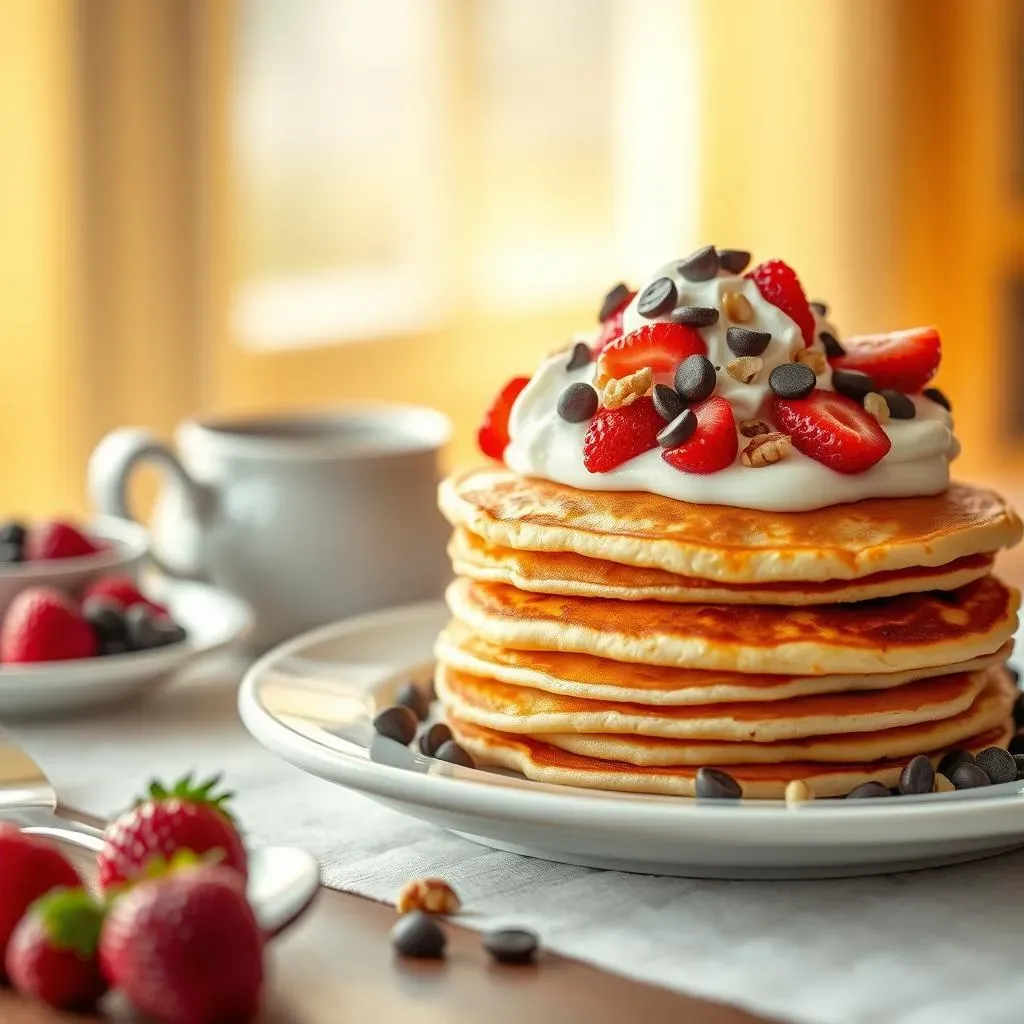
The Classic Combos
Alright, now that your pancakes are cooked to perfection, it’s time for the best part: the toppings! You can't go wrong with the classics: a generous drizzle of pure maple syrup, a dollop of fresh whipped cream, and a handful of juicy berries. Think of it as a blank canvas, ready for your artistic touch. Fresh strawberries, blueberries, and raspberries are always a hit, and they add a burst of freshness that cuts through the richness of the pancakes. If you're feeling a bit fancy, you can even make a quick berry compote by simmering the berries with a touch of sugar and lemon juice. It's all about layering those flavors.
For a little extra indulgence, consider adding some chocolate chips to the batter before cooking, or drizzle melted chocolate on top after. I’m a big fan of a little bit of crunch, so chopped nuts like pecans or walnuts are always a welcome addition. And don't forget a dusting of powdered sugar for that picture-perfect finish. It's the little things that make a difference! If you're looking for a way to make these pancakes even more special, check out our recipe for gluten-free pancakes for special occasions.
Classic Toppings | Why They Work |
|---|---|
Pure Maple Syrup | Adds sweetness and flavor |
Fresh Whipped Cream | Adds richness and texture |
Fresh Berries | Adds freshness and color |
Chocolate Chips | Adds a touch of indulgence |
Chopped Nuts | Adds crunch and flavor |
Powdered Sugar | Adds visual appeal |
Get Creative
Ready to go beyond the basics? Let’s get a little adventurous! If you're a fan of the sweet and savory combo, try topping your pancakes with some crispy bacon or sausage, a fried egg, and a drizzle of maple syrup. It might sound weird, but trust me, it's amazing. Or, how about a tropical twist? Some shredded coconut, sliced bananas, and a dollop of Greek yogurt will transport you to a sunny beach. If you are looking for a recipe that includes banana, you can check our gluten-free pancake recipe using banana. And if you’re feeling really adventurous, try a lemon curd or a homemade caramel sauce.
Don’t be afraid to experiment with different flavors and textures. A smear of peanut butter or Nutella is always a good idea, or you can go the healthy route and add some chia seeds or flaxseed meal for an extra boost of nutrients. The possibilities are endless! The best part about pancakes is that they are a blank canvas, ready for whatever your imagination can come up with. So go ahead, get creative, and have some fun with it! If you have some berries, you can check out our gluten-free pancake recipe with berries.
- Sweet and Savory: Bacon, egg, and syrup
- Tropical Twist: Coconut, bananas, and yogurt
- Nutty Delights: Peanut butter or Nutella
- Healthy Boost: Chia or flaxseed meal
Keeping Them Warm and Freezing for Later
Keeping Them Warm and Freezing for Later
Keeping Pancakes Warm
Okay, so you've made a stack of beautiful pancakes, but your brunch crew isn't quite ready to dig in. What do you do? Don't worry, I've got you covered. The easiest way to keep your pancakes warm is to place them on a baking sheet in a low oven. Set your oven to about 200°F (95°C), and they'll stay nice and toasty without drying out. You can also use a wire rack on top of the baking sheet to allow air to circulate, preventing the bottoms from getting soggy. Another option is to use a warming drawer if you have one; it's perfect for keeping pancakes at the ideal temperature. If you don't have either, a covered plate on the counter will work in a pinch, though they won't stay as warm for as long. Remember, nobody likes a cold pancake!
If you're dealing with a small batch, you can stack your cooked pancakes on a plate and cover it loosely with foil. This will trap some of the heat and keep them warm for a short time. However, for larger batches or longer periods, the oven method is definitely the way to go. Also, make sure to avoid stacking them too high, as the ones at the bottom might get a bit squished. If you’re looking for a recipe that will help with sensitive stomachs, check out our recipe for sensitive stomachs. It's always good to be prepared, especially when you’re serving a crowd.
Method | Pros | Cons |
|---|---|---|
Low Oven (200°F) | Keeps pancakes warm and dry | Requires oven use |
Warming Drawer | Ideal temperature control | Requires a warming drawer |
Covered Plate | Simple and easy | Doesn't keep warm for long |
Freezing Pancakes for Future Feasts
Sometimes, you end up with more pancakes than you can possibly eat. Don't let those beauties go to waste! Freezing pancakes is super easy, and it means you can have a quick and delicious breakfast ready any time. First, let your pancakes cool completely on a wire rack. Then, place them in a single layer on a baking sheet lined with parchment paper and pop them in the freezer for about 1-2 hours, or until they're frozen solid. This prevents them from sticking together when you store them. Once frozen, transfer the pancakes to a freezer-safe bag or container. They'll keep for up to 2-3 months. If you’re looking for a recipe that doesn't use eggs, you can check our gluten-free pancake recipe without eggs. I love having some on hand for those busy mornings when I don't have time to cook.
When you're ready to enjoy your frozen pancakes, you can reheat them in a few different ways. The microwave is the quickest option, but it can make them a bit soft. A toaster oven or regular oven will give you a better result, keeping them crispier. You can also reheat them on a lightly greased skillet over medium heat. No matter which method you choose, make sure to reheat them thoroughly. It's like a little gift to your future self!
- Cool Completely: Before freezing
- Freeze Individually: On a baking sheet
- Store in Freezer Bags: For up to 3 months
- Reheat: Microwave, toaster oven or skillet
Nutritional NittyGritty
Nutritional NittyGritty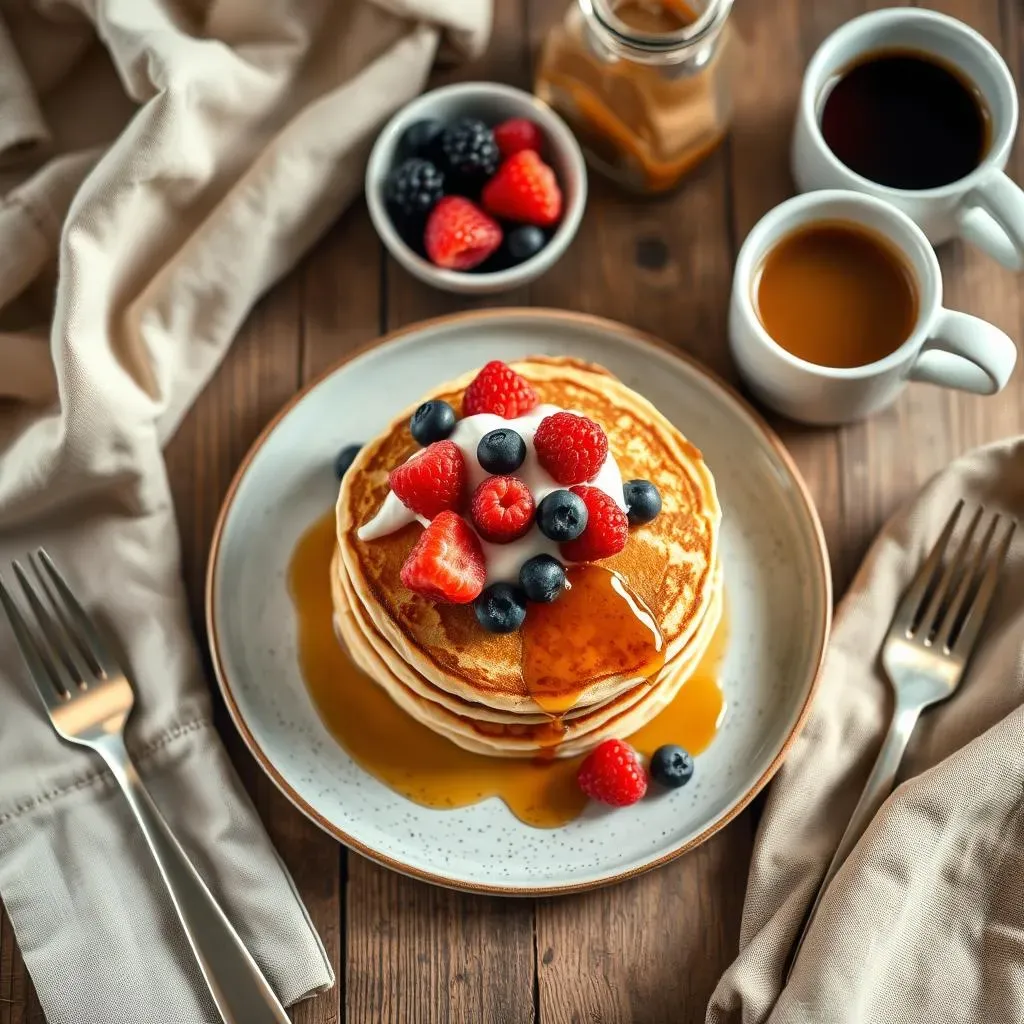
Okay, let's talk about the nutritional side of things. Now, I'm not a dietitian, but I do know that what you put into your body matters, even when it comes to pancakes. Gluten-free pancakes, like their regular counterparts, are primarily a source of carbohydrates, which give you energy. But the type of flour you use can make a difference. A good gluten-free blend will often include a mix of rice flour, tapioca starch, and potato starch, which are all relatively low in fiber. That's why it's important to balance your meal with some protein and healthy fats from your toppings. For those watching their weight, you can check our recipe for weight loss pancakes. The good news is that you can easily boost the nutritional value by making smart choices.
For example, if you're using plant-based milk, you'll get some vitamins and minerals, and if you add eggs, you'll get some protein. Toppings are where you can really make a difference. Berries are packed with antioxidants, while nuts provide healthy fats and fiber. A dollop of Greek yogurt adds protein and calcium. Be mindful of the amount of syrup or sugar you use; it can quickly add up and increase the calorie count. I like to use pure maple syrup sparingly because it tastes better and is a bit more nutritious than pancake syrup. If you're looking for a recipe that uses honey, our recipe for pancakes with honey is a good option, just remember that honey can increase the calorie count as well. Remember, it's all about balance and making choices that work for your body and your goals.
Nutrient | Why it's Important |
|---|---|
Carbohydrates | Provide energy |
Protein | Helps with satiety and muscle repair |
Fiber | Aids digestion and keeps you full |
Vitamins and Minerals | Support overall health |
Healthy Fats | Important for brain function |
If you are looking for a recipe that uses plant based milk, you can check our recipe for pancakes with plant based milk.
Reader Raves and Adaptations
Reader Raves and Adaptations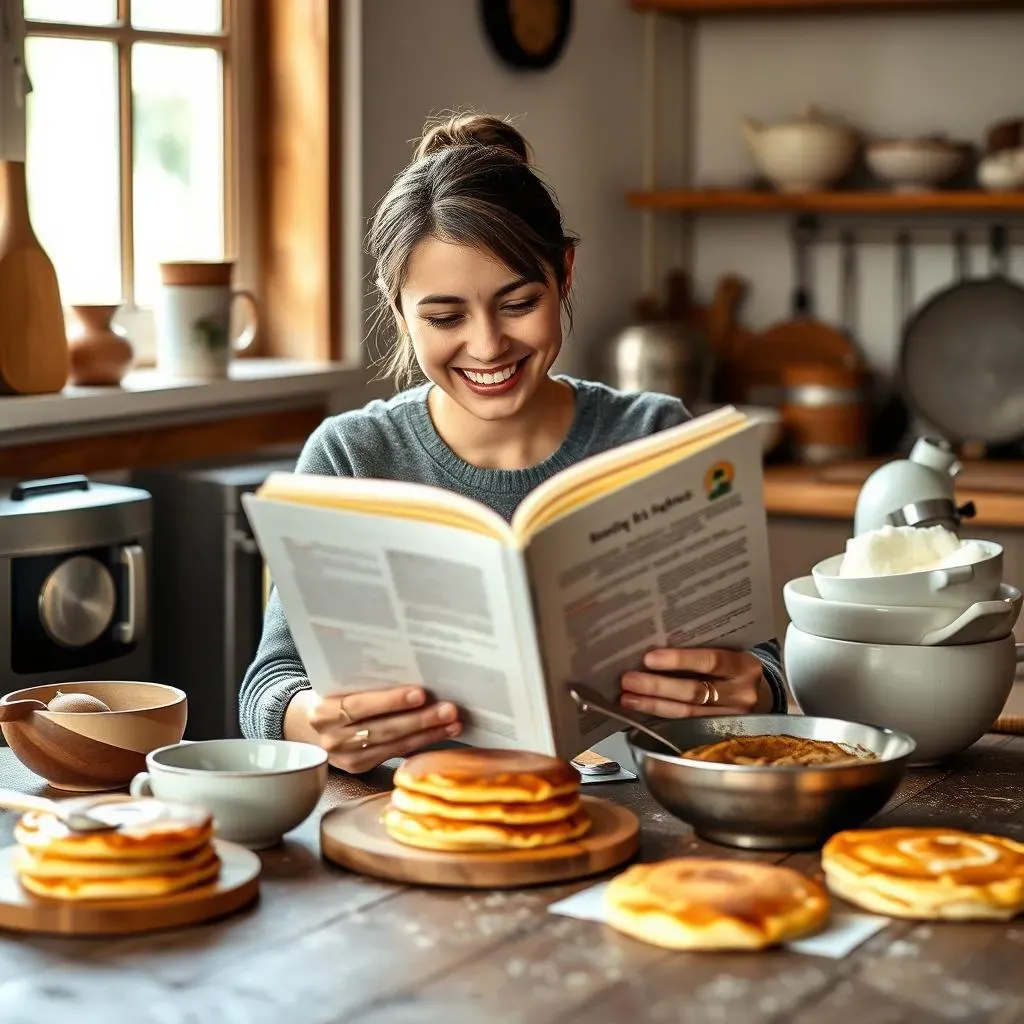
Real Feedback from Real People
It's always fun to see how others tweak and enjoy a recipe, and this gluten-free pancake recipe is no exception! I've had so many readers share their experiences, and it's been amazing to hear how this recipe has become a weekend staple in their homes. Some folks have mentioned that their kids, who usually turn their noses up at anything gluten-free, absolutely love these pancakes. That's a win in my book! Others have found that adding a bit of lemon zest to the batter gives them a nice little zing. And a few have even turned them into savory pancakes by adding herbs and spices, which I think is brilliant. Remember, cooking is an art, not a science, feel free to experiment and make it your own!
One reader with celiac disease mentioned that this is the best gluten-free pancake recipe they have ever tried, which is a huge compliment! It's so rewarding to know that this recipe is helping people with dietary restrictions enjoy delicious pancakes without any worries. I've also received a lot of questions about substitutions, and I've tried my best to answer them all. For example, if you are looking for a recipe without xanthan gum, you can check out our gluten-free pancake recipe without xanthan gum. It's great to see how adaptable this recipe is. It's not just about following the instructions, it's about making something that works for you and your family.
Reader Feedback | Adaptation |
|---|---|
Kids love them | Great for picky eaters |
Lemon zest addition | Adds a citrusy zing |
Savory pancake version | Experiment with herbs and spices |
Best for celiacs | Perfect for dietary restrictions |
Making it Your Own
The beauty of a good recipe is that it's a starting point, not a rigid set of rules. Don't be afraid to play around with the ingredients and find what works best for you. If you're vegan, you can easily substitute the eggs with flaxseed meal or a commercial egg replacer. I have some readers who have substituted the milk with coconut milk for a richer flavor, and they love it! Also, if you want a protein boost, check out our gluten-free pancake recipe with protein powder. It's all about making the recipe work for your dietary needs and preferences. If you're looking for a dairy-free option, you can check our gluten-free pancake recipe with dairy-free options. These pancakes are just a base for your creativity.
Some readers have even shared their favorite toppings, which have been great inspiration for me as well! Someone mentioned that they love to add a dollop of lemon curd and some fresh raspberries, which sounds absolutely heavenly. Another reader suggested a sprinkle of cinnamon and a drizzle of honey. It's amazing how simple tweaks can transform a dish. And if you are looking for a recipe that uses tapioca starch, check out our gluten-free pancake recipe with tapioca starch. Remember, the best recipes are the ones that are made with love and customized to your liking. So, go ahead, experiment, and have some fun in the kitchen!
- Vegan Options: Flaxseed or egg replacer
- Milk Alternatives: Coconut or almond milk
- Protein Boost: Add protein powder
- Topping Ideas: Lemon curd, raspberries, cinnamon, honey
Wrapping Up Our Gluten-Free Pancake Adventure
So there you have it, a straightforward path to gluten-free pancake perfection. From gathering your ingredients to mastering the griddle, you’re now equipped to handle any weekend brunch challenge. Remember, the best recipes are the ones you make your own, so don't be afraid to experiment with different flours, toppings, or even a dash of something unexpected. Whether you’re cooking for a crowd or just treating yourself, these pancakes are sure to hit the spot. And hey, if you’re feeling extra ambitious, try making a big batch and freezing some for a weekday treat. Happy flipping!
